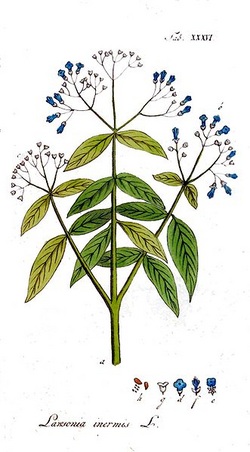HENNA

Henna (Lawsonia inermis) is a flowering plant used since antiquity to dye skin, hair, fingernails, leather and wool. The name is also used for dye preparations derived from the plant, and for the art of temporary tattooing based on those dyes. Additionally, the name is misused for other skin and hair dyes, such as black henna or neutral henna, which do not derive from the plant.
The English name "henna" comes from the Arabic حِنَّاء, pronounced [ħɪnˈnæːʔ] or colloquially حنا.
Description
Henna is a tall shrub or small tree, 2.6 m high. It is glabrous, multibranched with spine tipped branchlets. Leaves are opposite, entire, glabrous, sub-sessile, elliptical, and broadly lanceolate (1.5–5.0 cm x 0.5–2 cm), acuminate, having depressed veins on the dorsal surface. Henna flowers have four sepals and a 2 mm calyx tube with 3 mm spread lobes. Petals are obvate, white or red stamens inserted in pairs on the rim of the calyx tube. Ovary is four celled, style up to 5 mm long and erect. Fruits are small, brownish capsules, 4–8 mm in diameter, with 32–49 seeds per fruit, and open irregularly into four splits.
Uses
Henna has been used since the Bronze Age to dye skin (including body art), hair, fingernails, leather, silk and wool. In several parts of the world it is traditionally used in various festivals and celebrations. There is mention of henna as a hair dye in Indian court records around 400 CE, in Rome during the Roman Empire, and in Spain during Convivencia. It was listed in the medical texts of the Ebers Papyrus (16th c BCE Egypt)[4] and by Ibn Qayyim al-Jawziyya (14th c CE (Syria and Egypt) as a medicinal herb. In Morocco, wool is dyed and ornamented with henna, as are drumheads and other leather goods.
Use of henna for body art has enjoyed a recent renaissance due to improvements in cultivation, processing, and the emigration of people from traditional henna-using regions.
For skin dyeing, a paste of ground henna (either prepared from a dried powder or from fresh ground leaves) is placed in contact with the skin from a few hours to overnight. Henna stains can last a few days to a month depending on the quality of the paste, individual skin type, and how long the paste is allowed to stay on the skin.
Henna also acts as an anti-fungal and a preservative for leather and cloth. Henna flowers have been used to create perfume since ancient times, and henna perfume is experiencing a resurgence. Henna repels some insect pests and mildew.
Henna's coloring properties are due to lawsone, a burgundy organic compound that has an affinity for bonding with protein. Lawsone is primarily concentrated in the leaves, especially in the petioles of the leaf. Lawsone content in leaves is negatively correlated with the number of seeds in the fruits.
The English name "henna" comes from the Arabic حِنَّاء, pronounced [ħɪnˈnæːʔ] or colloquially حنا.
Description
Henna is a tall shrub or small tree, 2.6 m high. It is glabrous, multibranched with spine tipped branchlets. Leaves are opposite, entire, glabrous, sub-sessile, elliptical, and broadly lanceolate (1.5–5.0 cm x 0.5–2 cm), acuminate, having depressed veins on the dorsal surface. Henna flowers have four sepals and a 2 mm calyx tube with 3 mm spread lobes. Petals are obvate, white or red stamens inserted in pairs on the rim of the calyx tube. Ovary is four celled, style up to 5 mm long and erect. Fruits are small, brownish capsules, 4–8 mm in diameter, with 32–49 seeds per fruit, and open irregularly into four splits.
Uses
Henna has been used since the Bronze Age to dye skin (including body art), hair, fingernails, leather, silk and wool. In several parts of the world it is traditionally used in various festivals and celebrations. There is mention of henna as a hair dye in Indian court records around 400 CE, in Rome during the Roman Empire, and in Spain during Convivencia. It was listed in the medical texts of the Ebers Papyrus (16th c BCE Egypt)[4] and by Ibn Qayyim al-Jawziyya (14th c CE (Syria and Egypt) as a medicinal herb. In Morocco, wool is dyed and ornamented with henna, as are drumheads and other leather goods.
Use of henna for body art has enjoyed a recent renaissance due to improvements in cultivation, processing, and the emigration of people from traditional henna-using regions.
For skin dyeing, a paste of ground henna (either prepared from a dried powder or from fresh ground leaves) is placed in contact with the skin from a few hours to overnight. Henna stains can last a few days to a month depending on the quality of the paste, individual skin type, and how long the paste is allowed to stay on the skin.
Henna also acts as an anti-fungal and a preservative for leather and cloth. Henna flowers have been used to create perfume since ancient times, and henna perfume is experiencing a resurgence. Henna repels some insect pests and mildew.
Henna's coloring properties are due to lawsone, a burgundy organic compound that has an affinity for bonding with protein. Lawsone is primarily concentrated in the leaves, especially in the petioles of the leaf. Lawsone content in leaves is negatively correlated with the number of seeds in the fruits.
